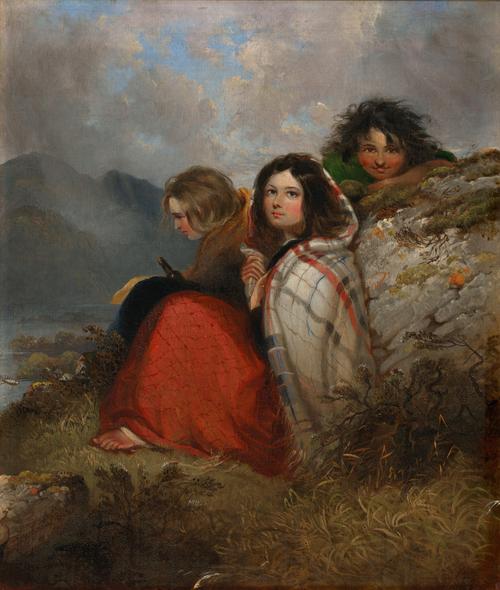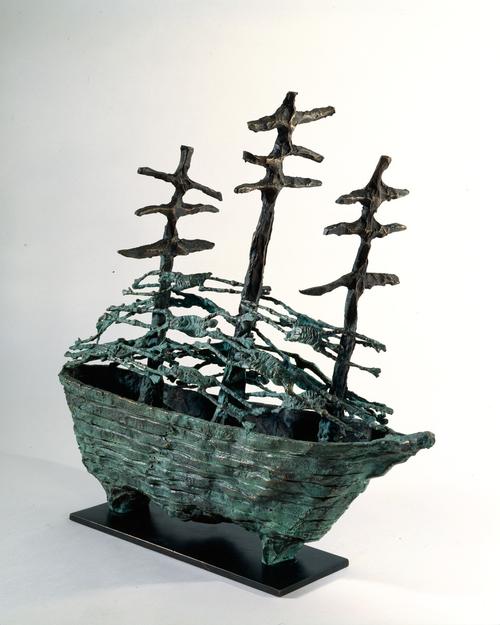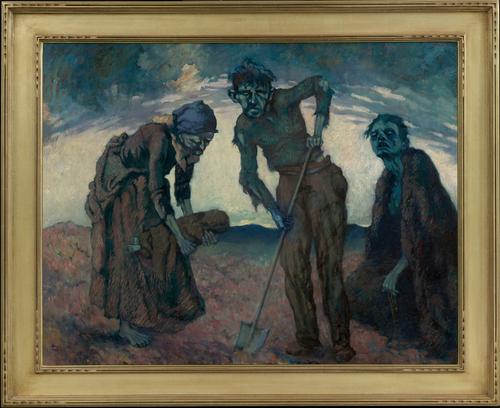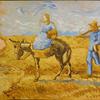Ireland’s Great Hunger Museum Opens to the Public on October 11; Nearly 100 Works in a Variety of Visual Media on View
- HAMDEN, Connecticut
- /
- October 04, 2012

Quinnipiac University Opens Ireland’s Great Hunger Museum, Músaem an Ghorta Mhóir, to the Public on October 11, 2012
Nearly 100 works by Irish and American Artists in a Variety of Visual Media Relating to the Catastrophe that Devastated Ireland on View
Hamden, Connecticut, October 4, 2012 –Quinnipiac University President John L. Lahey is proud to announce the public opening of Ireland’s Great Hunger Museum, Músaem an Ghorta Mhóir, on October 11, 2012. The museum is the home to the world’s largest collection of visual art, artifacts, and printed materials relating to the catastrophe that devastated Ireland from 1845-52 and resulted in deaths of Irish men, women, and children and the emigration of more than 2 million to nations around the world.
“The museum will preserve, build, and present its art collection in order to stimulate reflection, inspire imagination, and advance awareness of Ireland’s Great Hunger and its long aftermath on both sides of the Atlantic,” said Lahey, who has been widely honored for his visionary leadership in assembling the collection, begun in 1997 when he was grand marshal of the New York City St. Patrick’s Day Parade.
Niamh O'Sullivan, professor emeritus of visual culture, the National College of Art and Design in Dublin, is the inaugural curator of the museum’s collection; and Grace Brady, former administrator at The Metropolitan Museum of Art, serves as executive director of the museum.
The collection is filled with history and powerful stories about the Irish Famine and features nearly 100 original works by noted contemporary Irish and American artists in a variety of visual media, including sculptors John Behan, Rowan Gillespie, Glenna Goodacre, and Eamonn O'Doherty, and visual artists Robert Ballagh, Alanna O'Kelly, Brian Maguire, and Hughie O'Donoghue, as well as a number of important 19th and 20th century paintings by artists such as James Brenan, Daniel MacDonald, James Arthur O'Connor, Lilian Davidson, and Jack B. Yeats. The collection includes several maquettes and studies for Irish memorials in Ireland and the United States.

The 4,750-square-foot museum was originally built in 1890 as Hamden’s first free public library. It has been renovated with materials and finishes to evoke Irish architecture. Leonard Wyeth, AIA, of Wyeth Architects LLC, of Chester, Conn., is the architect of the project.
Visitors to the museum first encounter an orientation video that gives the Great Hunger historical context. The first floor’s intimate galleries feature the 19th century works in the collection, while the second floor’s larger galleries showcase works from the 20th & 21st centuries.
Many artists did not depict the true horrors of the Great Hunger. Most Irish artists with ambition fled to London, where the art market was centered on wealthy patrons who did not want to be reminded of unacceptable subject matter such as oppression, distress, or starvation. Few British artists who did use the Famine as subject matter muted the atrocities of actual events, for instance, George Frederic Watts depicted healthy looking well-dressed peasants in his painting The Irish Famine (ca. 1849).
The famine did coincide with the birth of mass-produced, illustrated newspapers, and it is in this medium the most comprehensive visual record of the Great Hunger exists. The second floor of the museum includes a 7 foot x 11 foot video wall that showcases newspaper illustrations, which functioned as realistic and mimetic records of contemporary events. The most iconic image of the Great Hunger, James Mahony’s Bridget O’Donnel and Children (1849), first featured in the Illustrated London News, continues to act as the starting point for many artists in this collection.

Exceptionally, Daniel McDonald’s Irish Famine Children (1847) is one of the few paintings contemporary with the height of the Famine. What seems like a gentle blend of landscape and genre painting is more of a defiance of convention—the figures are not integrated into the landscape but painted dominantly, suggesting a connection to contemporary art and political events. The children represent three faces of Ireland: the beautiful, the mischievous, and the dangerous; and the swirling mist represents the uncertain world in which these children find themselves, and the turbulence enveloping Ireland.
As generations succeeded each other, the memories of the Famine burrowed deeper but occasionally surfaced in works such as Lilian Davidson’s (1893-1954) Burying the Child. Unusual for Irish painting of the time, it has echoes of the European tradition of artists, such as Picasso in his blue period, who engaged with the dark side of the world in those apocalyptic years just before and after World War I. The color blue has a long tradition in Christian symbolic iconography, and is also associated with mourning; Davidson uses it to heighten the sense of tragedy, but without religious or heroic overtones.
The loss of life, guilt of the survivors, erosions of language and culture, scarring of the landscape, and the warping of memory continued to be trans-generational issues in Ireland and remained largely unaddressed in the visual arts until the 1990s. Alanna O’Kelly addresses these issues in her work A Kind of Quietism (1990). Photos of Irish landscapes overlaid with texts taken from historical sources provide harrowing accounts of the Great Hunger.
Kieran Tuohy works with hard black oak from the forests that once covered Ireland. Using wood, he tells stories of Ireland’s Famine, from which he believes the country has never fully recovered. His sculpture Thank you to the Choctaw (2005) is rich in the symbolism of giving and receiving—in 1847, the Choctaw Indian tribe in America sent money to Ireland to help those who were suffering. Tuohy parallels a totem-pole-style narrative with the intricacies of the Celtic way of storytelling.
Among the maquettes in the collection, and the first piece acquired by the museum, is Rowan Gillespie’s The Victim (1998), a quintessential figure representing every one of the millions who died from starvation or disease, or emigrated. It is part of a series of works commemorating the 150th anniversary of the Famine, executed by Gillespie as studies for the dramatic Famine memorial on Custom House Quay in Dublin. This small figure conjures up the enormity of the catastrophe, and yet, as Gillespie says, this piece “is about the miracle of human life in a galaxy of indifference.” John Behan’s Famine Ship (2000) is a model of his National Famine Memorial, the largest bronze sculpture ever commissioned in Ireland. Situated in County Mayo at the foot of Croagh Patrick, the piece vividly captures the loss of life and suffering in Ireland.
Ireland’s Great Hunger Museum, Músaem an Ghorta Mhóir
3011 Whitney Avenue, Hamden, CT 06518
203-582-6500 / www.ighm.org
Admission is free
Hours:
Wednesday, Friday, and Saturday: 10:00 a.m.-5:00 p.m.
Thursday: 10:00 a.m.-7:00 p.m.
Sunday 1:00-5:00 p.m.
Closed Monday and Tuesday
Quinnipiac is a private, coeducational, nonsectarian institution located 90 minutes north of New York City and two hours from Boston. The university enrolls 6,200 full-time undergraduate and 2,300 graduate students in 58 undergraduate and more than 20 graduate programs of study in its School of Business and Engineering, School of Communications, School of Education, School of Health Sciences, School of Law, Frank H. Netter MD School of Medicine, School of Nursing and College of Arts and Sciences. Quinnipiac consistently ranks among the top regional universities in the North in U.S. News & World Report’s America’s Best Colleges issue. The 2013 issue of U.S. News & World Report’s America’s Best Colleges named Quinnipiac as the top up-and-coming school with master’s programs in the Northern Region. Quinnipiac also is recognized in Princeton Review’s “The Best 377 Colleges.” For more information, please visit www.quinnipiac.edu. Connect with Quinnipiac on Facebook at www.facebook.com/quinnipiacuniversity and follow Quinnipiac on Twitter @QuinnipiacU.
###
High resolution images are available on request.
Media Contacts:
John W. Morgan, associate vice president for public relations, Quinnipiac University
(203) 582-5359 (office)
(203) 206-4449 (cell)
Daniela Stigh, Vice President, Rubenstein Communications
(212) 843-8269





100x100_c.jpg)

5100x100_c.jpg)







